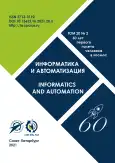Periodogram Estimating the Spectral Power Density Based upon Signals’ Binary-Sign Stochastic Quantization Using Window Functions
- Authors: Yakimov V.N1
-
Affiliations:
- Samara State Technical University
- Issue: Vol 20, No 2 (2021)
- Pages: 341-370
- Section: Digital information telecommunication technologies
- URL: https://journal-vniispk.ru/2713-3192/article/view/266306
- DOI: https://doi.org/10.15622/ia.2021.20.2.4
- ID: 266306
Cite item
Full Text
Abstract
About the authors
V. N Yakimov
Samara State Technical University
Email: yvnr@hotmail.com
Molodogvardeyskaya St. 244
References
- Шахтарин Б.И., Ковригин В.А. Методы спектрального оценивания случайных процессов // М.: Горячая линия-Телеком. 2011. 256 с.
- Marple Jr.S.L. Digital Spectral Analysis with Applications: Second edition // Dover Publications Inc. 2019. 432 p.
- Oppenheim A.V., Schafer R.W. Discrete-Time Signal Processing: Third edition // Pearson Higher Education. 2010. 1108 p.
- Bendat J.S., Piersol A.G. Random Data: Analysis and Measurement Procedures. Fourth edition // Wiley. 2010. 621 p.
- Alessio S.M. Digital Signal Processing and Spectral Analysis for Scientists: Concepts and Applications // Springer. 2016. 900 p.
- Stoica P., Moses R.L. Spectral Analysis of Signals // Pearson Prentice Hall. Upper Saddle River. 2005. 452 p.
- Percival D.B., Walden A.T. Spectral Analysis for Univariate Time Series // Cambridge University Press. 2020. 692 p.
- Фихтенгольц Г.М. Курс дифференциального и интегрального исчисления. Т. 2. 8-изд. // М.: Физматлит. 2003. 864 с.
- Oberguggenberger M., Ostermann A. Analysis for Computer Scientists Foundations, Methods and Algorithms // Springer. 2018. 378 p.
- Ульянов М.В. Ресурсно-эффективные компьютерные алгоритмы. Разработка и анализ // М.: Физматлит. 2008. 304 с.
- Kleinberg J., Tardos E. Algorithm Design // Pearson. 2006. 838 p.
- Blahut R.E. Fast Algorithms for Signal Processing // Cambridge University Press. 2010. 453 p.
- Bi G., Zeng Y. Transforms and Fast Algorithms for Signal Analysis and Representations // Birkhauser. 2004. 422 p.
- Britanak V., Rao K.R. Cosine-/Sine-Modulated Filter Banks: General Properties, Fast Algorithms and Integer Approximations // Springer. 2018. 645 p.
- Chu E. Discrete and Continuous Fourier Transforms: Analysis, Applications and Fast Algorithms // CRC Press, Taylor and Francis Group. 2008. 398 p.
- Madisetti V.K. (editor-in-chief). The Digital Signal Processing Handbook, Second edition: Digital Signal Processing Fundamentals // CRC Press, Taylor and Francis Group. 2010. 904 p.
- Stepanov A.A. Rose D.E. From Mathematics to Generic Programming // Addison-Wesley Professional. 2015. 292 p. 310.
- Kester W. (Editor). Analog-Digital Conversion // Analog Devices. 2004. 1138 p.
- Pelgrom M. Analog-to-Digital Conversion // Springer. 2017. 548 p.
- Bhattacharyya S.S., Deprettere E.F., Leupers R., Takala J. (Eds.) Handbook of Signal Processing Systems // Springer. 2019. 1200 p.
- Горбунов Ю.Н., Куликов Г.В., Шпак А.В. Радиолокация: стохастический подход / Под ред. Ю.Н. Горбунова // М.: Горячая линия-Телеком. 2016. 520 с.
- Мирский Г.Я. Характеристики стохастической взаимосвязи и их измерения // М.: Энергоиздат. 1982. 320 с.
- Max J. Methodes et techniques de traitement du signal et applications aux mesures physiques. Tome 1: Principes generaux et methodes classiques // Masson, Paris. 1996. 354 p.
- Papadopoulos H.C., Wornell G.W., Oppenheim A.V. Sequential Signal Encoding From Noisy Measurements Using Quantizers with Dynamic Bias Control // IEEE Transactions on information theory. 2001. vol. 47. no. 3. pp. 978–1002.
- Yakimov V.N. Direct Spectral Power Density Estimation from a Discrete-Time Representation of Stochastic Analog Quantization for an Analog Random Process // Measurement Techniques. 2009. vol. 52. no. 3. pp. 223–230.
- Якимов В.Н. Цифровой комплексный статистический анализ на основе знакового представления случайных процессов // Известия самарского научного центра РАН. 2016. Т. 18. № 4(7). С. 1346–1353.
- Isla J., Celga F. The Use of Binary Quantization for the Acquisition of Low SNR Ultrasonic Signals: a Study of the Input Dynamic Range // IEEE Transactions on Ultrasonics, Ferroelectrics, and Frequency Control. 2016. vol. 63. no. 9. pp. 1474–1482.
- Zhai Q., Wang Y. Noise Effect on Signal Quantization in an Array of Binary Quantizers // Signal Processing. 2018. vol. 152. pp. 265–272.
- Diao J.-D., Guo J., Sun C.-Y. Event-Triggered Identification of Fir Systems with Binary-Valued Output Observations // Automatica. 2018. vol. 98. pp. 95–102.
- Law A.M. Simulation Modeling and Analysis: Fifth edition // McGraw-Hill Education. 2015. 804 p.
- Zeigler B.P., Muzy A., Kofman E. Theory of Modeling and Simulation Discrete Event and Iterative System Computational Foundations // Academic Press. 2019. 667 p.
- Фихтенгольц Г.М. Курс дифференциального и интегрального исчисления. Т. 1. 8-изд. // М.: Физматлит. 2003. 680 с.
- Дворкович В.П., Дворкович А.В. Оконные функции для гармонического анализа сигналов. Изд. 2-е. // М.: Техносфера. 2016. 208 с.
- Prabhu K.M.M. Window Functions and Their Applications in Signal Processing // CRC Press, Taylor and Francis Group. 2014. 382 p.
- Poularikas A.D. The Handbook of Formulas and Tables for Signal Processing // CRC Press, IEEE Press. 1999. 838 p.
- Allen R.L., Mills D.W. Signal Analysis: Time, Frequency, Scale, and Structure // Wiley-IEEE Press. 2004. 937 p.
- Yakimov V.N., Zaberzhinskij B.E., Mashkov A.V. Bukanova Yu.V. Multi-threaded Approach to Software High-speed Algorithms for Spectral Analysis of Multi-component Signals // Proceedings of IEEE XXI International Conference on Complex Systems: Control and Modeling Problems (CSCMP). 2019. pp. 698–701.
- Yakimov V.N., Gorbachev O.V. Firmware of the Amplitude Spectrum Evaluating System for Multicomponent Processes // Instruments and Experimental Techniques. 2013. vol. 56. no. 5. pp. 540–545.
Supplementary files









